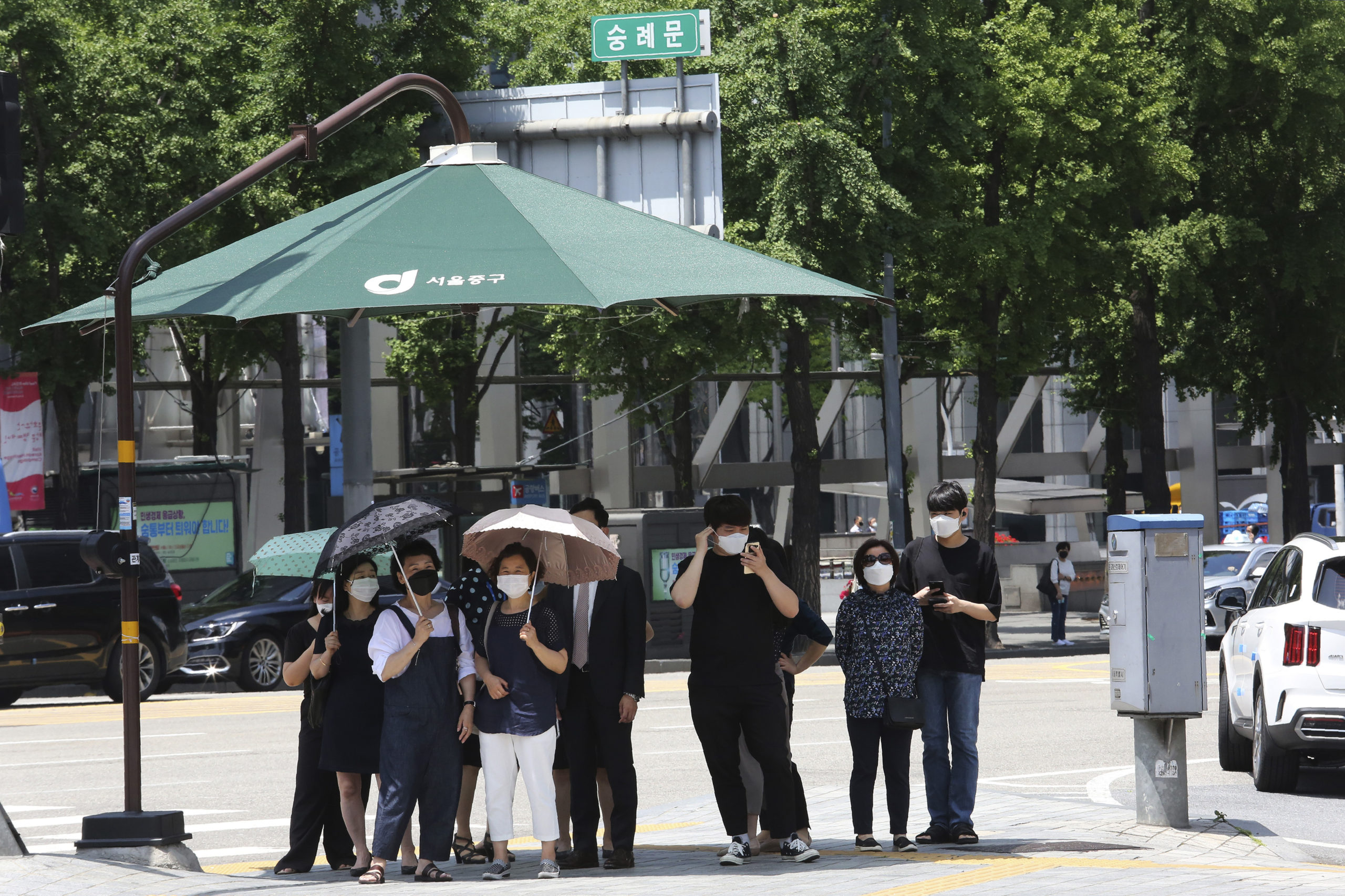
People, wearing face mask, wait to cross the road in Seoul, South Korea, Thursday, June 11, 2020. (AP Photo/Ahn Young-joon)
SEOUL, South Korea — Just weeks ago, South Korea was celebrating its hard-won gains against the coronavirus, easing social distancing, reopening schools and promoting a tech-driven anti-virus campaign President Moon Jae-in has called “K-quarantine.”
But a resurgence of infections in the Seoul region where half of South Korea’s 51 million people live is threatening the country’s success story and prompting health authorities to warn that action must be taken now to stop a second wave.
South Korea’s Centers for Disease Control and Prevention on Thursday reported 45 fresh cases of infection, a daily rise that has been fairly consistent since late May. Most have been in the Seoul metropolitan area, where health authorities have struggled to trace transmissions.
“Considering the quick transmission of COVID-19, there’s limits to what we can do with contact tracing alone to slow the spread,” said Yoon Taeho, a senior Health Ministry official during a virus briefing on Thursday, where he repeated a plea for residents in the capital area to stay at home.
Despite the concerns over the spike in infections, government officials have so far resisted calls to reimpose stronger social distancing guidelines after they were relaxed in April, citing concerns over hurting a fragile economy.
Their stance seems in contrast with the urgency conveyed by health experts, including KCDC director Jung Eun-kyeong, who has warned that the country could be sleepwalking into another huge COVID-19 crisis, but this time in its most populous region.
She has said health workers are struggling more and more to track transmissions that are spreading quickly and unpredictably as people increase their activities and practice less social distancing.
Jung’s concerns were echoed by Kwon Jun-wook, director of the National Institute of Health, who in a separate briefing on Thursday acknowledged that health authorities were only managing to “chase transmissions after belatedly discovering them.”
While South Korea saw a much larger surge of infections in February and March, when hundreds of new cases were reported every day, those had been easier to track. The majority then were concentrated in a single church congregation in Daegu, South Korea’s fourth-largest city with 2.5 million people.
The recent clusters have popped up just about everywhere around the capital.
At least 146 cases have been linked to workers at a large warehouse operated by local e-commerce giant Coupang, which has been accused of failing to implement preventive measures and having employees work even when sick.
Around 200 cases were linked to nightclubs and other entertainment venues, while more than 90 infections have been traced to church gatherings near Seoul.
At least 116 cases have been linked to door-to-door sellers hired by Richway, a health product provider. These cases are particularly worrisome because most of the sellers are in their 60s and 70s.
South Korea’s total cases are now 11,947, including 276 deaths. Most people have recovered, but the number of active cases rose back above 1,000 this week after dropping below the mark in mid-May.
Health authorities and hospital officials last week participated in an exercise for sharing hospital capacities between Seoul and nearby cities and ensure swift transports of patients so that a spike of cases in one area doesn’t overwhelm its hospital system.
“At the least, we might have to invest as much effort as we did until now, or even more,” to contain the new virus surge, Kwon said.
The spike of infections in the capital area has inspired second-guessing on whether officials were too quick to ease on social distancing.
The government in mid-April decided to lift administrative orders that advised entertainment and sports venues to close, allow professional sports to return to action without spectators and green-light a phased reopening of schools.
But Seoul and nearby cities restored some of the controls in recent weeks by shutting thousands of nightclubs, hostess bars and karaoke rooms. Resisting criticism from privacy advocates, officials have also started requiring entertainment venues, gyms and concert halls to register their customers with smartphone QR codes so they could be easily located when needed.
Health authorities have aggressively mobilized technological tools to trace contacts and enforce quarantines, with an infectious disease law strengthened after a 2015 outbreak of a different coronavirus, MERS, allowing them quick access to cellphone data, credit-card records and surveillance camera footage.
But since the easing of distancing, there has been a clear erosion in citizen vigilance, which, along with the highly effective contact tracing, has been credited for allowing the country to weather the epidemic without lockdowns.
While the Health Ministry and KCDC have repeatedly urged residents in the capital area to refrain from unnecessary gatherings and other public activity, data provided by cellphone carriers, credit-card companies and mass-transport operators over the past weekend indicated that people were just as active as before.
Government officials have said enforcing stricter distancing rules would be a difficult decision, considering the huge blow it could deal to the country’s weak economy, which the Bank of Korea says could shrink for the first time in 22 years.
It would also be hard to close schools again in a country where hyper-competitive schools and elite university degrees are seen as crucial to career prospects.
Prime Minister Chung Sye-kyun recently noted schools stayed open even during the 1950-53 Korean War and that it would be wrong to “fail the dreams and future of our children because of the current difficulties.”